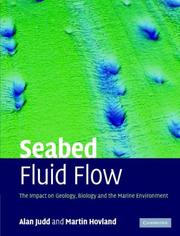| Listing 1 - 3 of 3 |
Sort by
|
Book
ISBN: 1281861456 9786611861452 1402084609 1402084617 9400794975 Year: 2008 Publisher: Dordrecht ; New York : Springer,
Abstract | Keywords | Export | Availability | Bookmark
 Loading...
Loading...Choose an application
- Reference Manager
- EndNote
- RefWorks (Direct export to RefWorks)
Deep-water coral reefs are found along large sections of the outer continental shelves and slopes of Europe, from North Cape to the Gulf of Cadiz, and because they also occur along the Atlantic seaboard of USA, the Gulf of Mexico, off Brazil, in the Mediterranean, and off New Zealand, they are currently being targeted by international groups of marine scientists. They have become popular and opportune deep-water research targets because they offer exciting frontier exploration, combined with a whole plethora of modern scientific methods, such as deep-sea drilling, sampling, remote control surveying and documentation. Furthermore they represent timely opportunities for further developments within the application of geochemistry, stable isotope research, bacterial sciences, including DNA-sequestering, and medical research (search for bioactive compounds). The Integrated Ocean Drilling Program (IODP) has arranged a deep-sea scientific drilling campaign on giant carbonate banks off Ireland. Because the reefs currently defy traditional marine-ecological theories, they represent future research opportunities and will enjoy scientific scrutiny for many years to come.
Deep sea corals. --- Coral reefs and islands. --- Marine biodiversity. --- Diversity, Marine biological --- Marine biological diversity --- Aquatic biodiversity --- Atolls --- Coral atolls --- Coral islands --- Reefs, Coral --- Islands --- Cold-water corals --- Deep corals --- Deep-water corals --- Structure-forming deep corals --- Anthozoa --- Deep-sea animals --- Hydrozoa --- Aquatic biology. --- Geology. --- Animal ecology. --- Oceanography. --- Freshwater & Marine Ecology. --- Animal Ecology. --- Oceanography, Physical --- Oceanology --- Physical oceanography --- Thalassography --- Earth sciences --- Marine sciences --- Ocean --- Animals --- Zoology --- Ecology --- Geognosy --- Geoscience --- Natural history --- Hydrobiology --- Water biology --- Aquatic sciences --- Biology --- Aquatic ecology . --- Aquatic biology

ISBN: 9780521819503 0521819504 9780511535918 9780521114202 0511269390 9780511269394 9780511269950 0511269951 0511535910 1280750324 9781280750328 051126836X 9780511268366 051126903X 9780511269035 9786610750320 6610750327 1107159423 9781107159426 0511320515 9780511320514 Year: 2007 Publisher: Cambridge New York Cambridge University Press
Abstract | Keywords | Export | Availability | Bookmark
 Loading...
Loading...Choose an application
- Reference Manager
- EndNote
- RefWorks (Direct export to RefWorks)
Seabed fluid flow involves the flow of gases and liquids through the seabed. Such fluids have been found to leak through the seabed into the marine environment in seas and oceans around the world - from the coasts to deep ocean trenches. This geological phenomenon has widespread implications for the sub-seabed, seabed, and marine environments. Seabed fluid flow affects seabed morphology, mineralization, and benthic ecology. Natural fluid emissions also have a significant impact on the composition of the oceans and atmosphere; and gas hydrates and hydrothermal minerals are potential future resources. This book describes seabed fluid flow features and processes, and demonstrates their importance to human activities and natural environments. It is targeted at research scientists and professionals with interests in the marine environment. Colour versions of many of the illustrations, and additional material - most notably feature location maps - can be found at www.cambridge.org/9780521819503.
Fluid mechanics --- Hydrosphere --- Hydrobiology --- Petroleum technology. Petrochemistry --- Ocean bottom. --- Marine sediments --- Upwelling (Oceanography) --- Deep-sea ecology. --- Marine ecology --- Ocean circulation --- Gases in marine sediments --- Bottom of the ocean --- Floor of the ocean --- Ocean floor --- Sea bed --- Sea floor --- Seafloor --- Seabed --- Subsoil of the ocean floor --- Submarine topography --- Gas content. --- Ocean bottom ecology. --- Ocean bottom --- Seabed ecology --- Ecology

ISBN: 9780521819503 0521819504 Year: 2007 Publisher: New York Cambridge University Press
Abstract | Keywords | Export | Availability | Bookmark
 Loading...
Loading...Choose an application
- Reference Manager
- EndNote
- RefWorks (Direct export to RefWorks)
Fluid mechanics --- Hydrosphere --- Hydrobiology --- Petroleum technology. Petrochemistry
| Listing 1 - 3 of 3 |
Sort by
|

 Search
Search Feedback
Feedback About UniCat
About UniCat  Help
Help News
News